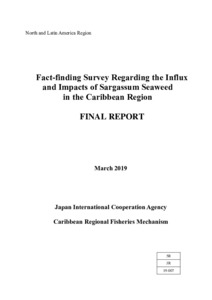| dc.coverage.spatial | Caribbean Sea | en_US |
| dc.coverage.spatial | Antigua and Barbuda | en_US |
| dc.coverage.spatial | Barbados | en_US |
| dc.coverage.spatial | Commonwealth of Dominica | en_US |
| dc.coverage.spatial | Grenada | en_US |
| dc.coverage.spatial | Saint Kitts and Nevis | en_US |
| dc.coverage.spatial | Saint Lucia | en_US |
| dc.coverage.spatial | Saint Vincent and the Grenadines | en_US |
| dc.coverage.spatial | Trinidad and Tobago | en_US |
| dc.date.accessioned | 2020-06-11T20:41:52Z | |
| dc.date.available | 2020-06-11T20:41:52Z | |
| dc.date.issued | 2019 | |
| dc.identifier.citation | Caribbean Regional Fisheries Mechanism (2019) Fact-finding Survey Regarding the Influx and Impacts of Sargassum Seaweed
in the Caribbean Region: final report. Belize, Caribbean Regional Fisheries Mechanism and Japan International Cooperation Agency, 91pp. DOI: http://dx.doi.org/10.25607/OBP-860 | en_US |
| dc.identifier.uri | http://hdl.handle.net/11329/1354 | |
| dc.identifier.uri | http://dx.doi.org/10.25607/OBP-860 | |
| dc.description.abstract | The Caribbean region has suffered a sudden increase in the influx of Sargassum seaweed since 2011, and
several countries in the region have requested support to the Government of Japan and the Japan
International Cooperation Agency (JICA). In response JICA with support from CRFM conducted a “Factfinding
survey regarding the influx and impacts of Sargassum seaweed in the Caribbean region” in order to
gather information on the scope of damages and impacts and to determine the possibility of providing further
support. The target countries included: Antigua and Barbuda, Barbados, Commonwealth of Dominica,
Grenada, Saint Kitts and Nevis, Saint Lucia, Saint Vincent and the Grenadines, and Trinidad and Tobago.
The objectives of this survey were to: (i) review the existing literature and initiatives in the region; (ii)
summarize the scope of damages and impacts caused by Sargassum seaweed in the target countries; (iii)
suggest potential countermeasures and determine the scope of support that JICA may be able to provide in
the future. In order to summarize the scope of damages and impacts caused by Sargassum influxes a number
of methods were utilized including: 1) virtual meetings with the target countries; 2) development and
circulation of questionnaires targeted at the fisheries divisions/departments; public sector agencies with
responsibility for beach clean-ups; hotel associations; and innovators/entrepreneurs using Sargassum and;
3) field missions to gather more detailed country-level data, information and knowledge. | en_US |
| dc.language.iso | en | en_US |
| dc.publisher | Caribbean Regional Fisheries Mechanism and Japan International Cooperation Agency | en_US |
| dc.subject.other | Sargassum | en_US |
| dc.subject.other | Management | en_US |
| dc.subject.other | Beach cleanup | en_US |
| dc.subject.other | Mitigation | en_US |
| dc.title | Fact-finding Survey Regarding the Influx and Impacts of Sargassum Seaweed in the Caribbean Region: final report. | en_US |
| dc.type | Report | en_US |
| dc.description.status | Published | en_US |
| dc.format.pages | 91pp. | en_US |
| dc.contributor.corpauthor | Caribbean Regional Fisheries Mechanism | en_US |
| dc.description.refereed | Refereed | en_US |
| dc.publisher.place | Belize | en_US |
| dc.subject.parameterDiscipline | Parameter Discipline::Biological oceanography::Macroalgae and seagrass | en_US |
| dc.description.currentstatus | Current | en_US |
| dc.description.sdg | 14.2 | en_US |
| dc.description.eov | Macroalgal canopy cover and composition | en_US |
| dc.description.bptype | Manual (incl. handbook, guide, cookbook etc) | en_US |
| obps.resourceurl.publisher | https://openjicareport.jica.go.jp/pdf/1000041359.pdf | en_US |
 Repository of community practices in Ocean Research, Applications and Data/Information Management
Repository of community practices in Ocean Research, Applications and Data/Information Management
